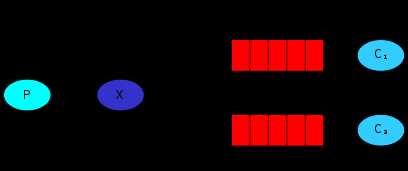Routing(路由模式)
Posted haizhilangzi
tags:
篇首语:本文由小常识网(cha138.com)小编为大家整理,主要介绍了Routing(路由模式)相关的知识,希望对你有一定的参考价值。
Routing(路由模式)
生产者将消息发送到direct交换器,在绑定队列和交换器的时候有一个路由key,生产者发送的消息会指定一个路由key,那么消息只会发送到相应key相同的队列,接着监听该队列的消费者消费信息.
Direct exchange
会把消息路由到那些binding key与routing key完全匹配的Queue中
我们可以看到绑定了两个队列的exchange X。第一个队列binding key 为orange,第二个binding key为两个,一个binding key为black,另一个binding key为green。
使用routing key为orange发布到交换机的消息 将被路由到队列Q1。routing key为black 或green的消息将转到Q2。所有其他消息将被丢弃。
Multiple Bindings
用相同的binding key 绑定多个队列,可以使用binding key 为black在X和Q1与Q2之间添加绑定。在这种情况下,exchange的行为将类似于扇出,并将消息广播到所有匹配的队列。routing key为black的消息将同时传递给 Q1和Q2
下面代码实现生产者和消费者的Direct模式
生产者代码:
public class DirectEmitLog { private static final String EXCHANGE_NAME = "direct_logs"; public static void main(String[] args) throws Exception { //获取连接 Connection connection = ConnectionUtil.getConnection("localhost", 5672, "/", "guest", "guest"); Channel channel = connection.createChannel(); //创建队列 channel.queueDeclare("direct_loge",false,false,false,null); //声明交换机, channel.exchangeDeclare(EXCHANGE_NAME, "direct"); String message="hello"; //发送消息 // for (int i = 0; i < 10; i++) { // String message = " message" + i; // System.out.println("[send]:" + message); //发送消息 channel.basicPublish(EXCHANGE_NAME, "err", null, message.getBytes("utf-8")); //} channel.close(); connection.close(); } }消费者代码:
public class DirectRecv { private final static String QUEUE_NAME = "direct_loge"; private static final String EXCHANGE_NAME = "direct_logs"; public static void main(String[] args) throws Exception { //获取连接 Connection connection = ConnectionUtil.getConnection("localhost", 5672, "/", "guest", "guest"); //声明通道 Channel channel = connection.createChannel(); channel.exchangeDeclare(EXCHANGE_NAME, "direct"); //声明队列队列 channel.queueDeclare(QUEUE_NAME, false, false, false, null); channel.queueBind(QUEUE_NAME, EXCHANGE_NAME, "err"); DeliverCallback deliverCallback = (consumerTag, delivery) -> { String message = new String(delivery.getBody(), "UTF-8"); System.out.println(" [x] Received '" + message + "'"); try { doWork(message); } catch (InterruptedException e) { e.printStackTrace(); } finally { System.out.println(" [x] Done"); //channel.basicAck(); //channel.basicNack(); } }; boolean autoAck = true; // acknowledgment is covered below channel.basicConsume(QUEUE_NAME, autoAck, deliverCallback, consumerTag -> { }); // DeliverCallback deliverCallback = new DeliverCallback(){ // @Override // public void handle(String consumerTag, Delivery delivery) throws IOException { // String message = new String(delivery.getBody(), "UTF-8"); // System.out.println(" [x] Received '" + message + "'"); // } // }; // // channel.basicConsume(QUEUE_NAME, true, deliverCallback, new CancelCallback(){ // @Override // public void handle(String consumerTag) throws IOException { // // } // }); } private static void doWork(String task) throws InterruptedException { for (char ch : task.toCharArray()) { if (ch == '.') Thread.sleep(1000); } } }SpringBoot相关代码:
@SpringBootApplication @EnableScheduling public class RabbitAmqpTutorialsApplication { public static void main(String[] args) throws Exception { SpringApplication.run(RabbitAmqpTutorialsApplication.class, args); } }@Configuration public class Tut4Config { @Bean public DirectExchange direct() { return new DirectExchange("tut.direct"); } private static class ReceiverConfig { @Bean public Queue autoDeleteQueue1() { return new AnonymousQueue(); } @Bean public Queue autoDeleteQueue2() { return new AnonymousQueue(); } @Bean public Binding binding1a(DirectExchange direct, Queue autoDeleteQueue1) { return BindingBuilder.bind(autoDeleteQueue1) .to(direct) .with("orange"); } @Bean public Binding binding1b(DirectExchange direct, Queue autoDeleteQueue1) { return BindingBuilder.bind(autoDeleteQueue1) .to(direct) .with("black"); } @Bean public Binding binding2a(DirectExchange direct, Queue autoDeleteQueue2) { return BindingBuilder.bind(autoDeleteQueue2) .to(direct) .with("green"); } @Bean public Binding binding2b(DirectExchange direct, Queue autoDeleteQueue2) { return BindingBuilder.bind(autoDeleteQueue2) .to(direct) .with("black"); } @Bean public Tut4Receiver receiver() { return new Tut4Receiver(); } } @Bean public Tut4Sender sender() { return new Tut4Sender(); } }public class Tut4Receiver { @RabbitListener(queues = "#{autoDeleteQueue1.name}") public void receive1(String in) throws InterruptedException { receive(in, 1); } @RabbitListener(queues = "#{autoDeleteQueue2.name}") public void receive2(String in) throws InterruptedException { receive(in, 2); } public void receive(String in, int receiver) throws InterruptedException { StopWatch watch = new StopWatch(); watch.start(); System.out.println("instance " + receiver + " [x] Received '" + in + "'"); doWork(in); watch.stop(); System.out.println("instance " + receiver + " [x] Done in " + watch.getTotalTimeSeconds() + "s"); } private void doWork(String in) throws InterruptedException { for (char ch : in.toCharArray()) { if (ch == '.') { Thread.sleep(1000); } } } }public class Tut4Sender { @Autowired private RabbitTemplate template; @Autowired private DirectExchange direct; AtomicInteger index = new AtomicInteger(0); AtomicInteger count = new AtomicInteger(0); private final String[] keys = {"orange", "black", "green"}; @Scheduled(fixedDelay = 1000, initialDelay = 500) public void send() { StringBuilder builder = new StringBuilder("Hello to "); if (this.index.incrementAndGet() == 3) { this.index.set(0); } String key = keys[this.index.get()]; builder.append(key).append(' '); builder.append(this.count.get()); String message = builder.toString(); template.convertAndSend(direct.getName(), key, message); System.out.println(" [x] Sent '" + message + "'"); } }
以上是关于Routing(路由模式)的主要内容,如果未能解决你的问题,请参考以下文章